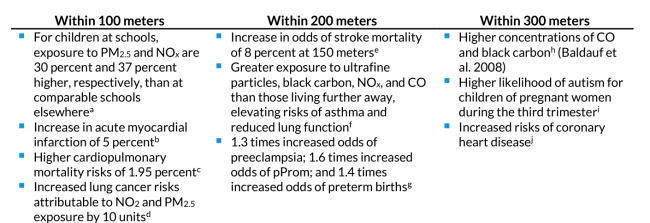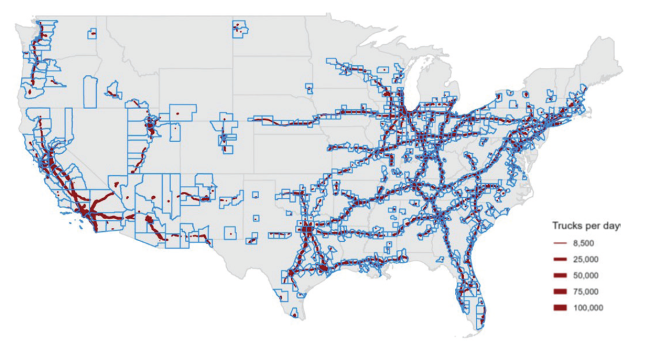Recent studies underscore the disproportionate impacts of diesel truck emissions in communities of color and low-income neighborhoods. Policymakers should help speed the transition to electric models to protect human health.
The market for electric trucks is growing and recent and pending regulations could boost this transition dramatically, particularly if the proposed EPA truck emissions rule is strengthened. While the greenhouse gas reduction benefits of electric trucks are substantial, an array of recent studies shine new light on the health and environmental justice benefits.
Replacing diesel trucks with electric trucks will mostly eliminate their emissions of nitrogen oxides (NOx) and fine particulate matter, which adversely affect human health. These benefits will be most significant where truck routes are commonly situated—in neighborhoods with people of color and low-income residents.
Trucks have significant emissions of pollutants that harm health
Research by the American Lung Association has found that trucks (medium- and heavy-duty vehicles, including buses) represent approximately 6% of the on-road vehicle fleet as of 2020, but generate 59% of on-road vehicle NOx emissions and 55% of particle pollution. As noted by the EPA, NOx and fine particle pollution can affect the lungs and heart, contributing to respiratory diseases such as asthma and heart problems.
Pollution is disproportionately affecting communities of color and low-income communities
Interstate highways were often routed through communities of color and low-income communities. In addition, as noted by the Urban Institute, highways and other major roads tend to reduce the property values of nearby residences, and one result is that a disproportionate share of people of color and people with low incomes live near them. The researchers cite studies showing substantial health problems for people living or going to school near these major roadways, as summarized in the table below.
Evidence on health effects of living or attending school near major roadways. Source: Urban Institute. Letter footnotes in the table refer to specific scientific papers that the researchers cite.
More broadly, numerous studies have found high pollutant concentrations in low-income communities and communities of color. For example, researchers at the Massachusetts Institute of Technology analyzed satellite sensor data and found higher nitrogen dioxide levels in low-income census tracts and those that had the smallest share of white residents. Likewise, researchers at the Harvard School of Public Health and the Center for Air, Climate and Energy Solutions (CACES), in two separate studies, found that African Americans and Hispanics have been exposed to higher average levels of PM2.5 (particles smaller than 2.5 microns in diameter) than whites. The Harvard study also includes Asian Americans in the higher exposure group and finds that lower-income groups had higher exposure than higher-income groups. The CACES study further examines the causes of this higher exposure. It links this in part to heavy vehicles, finding that people of color are more exposed to emissions from industry, light and heavy vehicles, and construction, while whites and Native Americans are more exposed to emissions from coal-fired power plants and agriculture.
Going a step further, a more recent Harvard School of Public Health study crossed PM exposure data with Medicare health records and found that lower PM2.5 exposure was associated with lower mortality in the total population, but even more so among marginalized subpopulations.
Electric trucks can improve health, particularly in environmental justice communities
Electric trucks don’t directly emit NOx (there are some indirect emissions from the share of power generated using fossil fuels), and they emit very few fine particles (just from tires and brakes). As a result, many of the emissions and health issues associated with diesel and gasoline trucks don’t apply to electric vehicles.
Researchers have extensively documented the emissions and health improvements that will be achieved with the widespread switch to electric trucks. An American Lung Association (ALA) study looked at the impact of electrifying trucks that travel along roads with at least 8,500 trucks passing per day, considering the health impacts in counties with such roads (see figure below). These counties account for about three-quarters of the U.S. population. The study looks at a steady transition to 100% zero-emission trucks by 2040 and 100% non-combustion electricity by 2035. ALA found that over the 2020–2050 period, such a future would avoid 66,800 premature deaths, 1.75 million asthma attacks, and 8.5 million lost workdays while providing $735 billion in public health benefits.
Roads with at least 8,500 trucks passing per day and their surrounding counties. Source: American Lung Association.
A Union of Concerned Scientists (UCS) study on truck electrification, done with the consulting firm ERM and the Natural Resources Defense Council, included a scenario where NOx emissions limits and vehicle sales requirements for trucks adopted by California are applied nationally. They find a majority of the health benefits are from reduced NOx levels, with smaller but still substantial benefits from reduced emissions of fine particles. Overall, they estimate that over the 2020–2050 period, the California regulatory package relative to an EPA baseline proposal would prevent about 23,000 premature deaths and provide net health benefits of about $270 billion. The UCS impacts are lower than the ALA impacts because UCS includes proposed EPA regulations in the baseline and does not include an assumption of combustion-free electricity.
A more direct link between truck electrification and community impacts is provided by a recent paper published in the journal Nature Sustainability. This study looks at the effects in the Chicago region if 30% of on-road heavy-duty vehicles are shifted to electric versions, with modeling conducted at the neighborhood level. The researchers found substantial reductions in NO2 and PM2.5 concentrations but increased ground-level ozone concentrations, the latter due to reduced ozone removal in urban areas due to reduced levels and interactions with NOx. They estimate 590 reduced deaths in the region due to lower NOx concentrations, 70 decreased deaths due to lower PM2.5 concentrations, but 50 more deaths due to higher ground-level ozone concentrations, for a net impact across all three pollutants of 610 deaths averted. Their neighborhood-level analysis found that the most substantial pollutant and health benefits are in communities with higher proportions of Black and Hispanic residents.
Policymakers should help speed the transition
Diesel and gasoline trucks produce substantial NOx and PM emissions, which harm public health. Households living along major truck routes suffer greater pollutant concentrations and health effects and are disproportionately Black, Hispanic, and low-income. Increased use of electric trucks will reduce pollutant concentrations and health effects and benefit marginalized communities along truck routes. As noted by the CACES study, heavy trucks are one of the major reasons that pollution concentrations, and hence the resulting health impacts, are highest in communities of color and other low-income communities.
In previous reports and blog posts we have highlighted some of the steps that policymakers can take to dramatically grow the market share of electric trucks. These include strengthening EPA’s proposed truck emission standard, additional states adopting California Advanced Clean Truck requirements, and proactively incorporating growing electric truck loads into distribution system planning.



